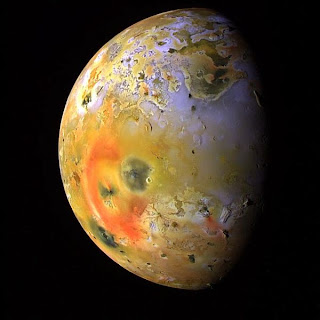Io, 4th largest moon of Sol's System. It's just a bit bigger than our Luna, yet oh so different.
For you see, Io is literally HELL in space. A moon of fire and magma, roiling land exploding, pits of burning damnation, etc. As such, the surface of Io is continually made anew, and thus has the fewest impact craters of any object save Sol itself.
This is a difference of 5 months. Huge zit out of nowhere - just before Space Prom, too.
A few other months. As you can see, in the blink of a geologic eye Io changes before us. Such is the temptation of HELL. Like Enceladus's CRYOVOLCANOES, Io's heat comes from tidal friction between Jupiter and the other large moons in the system. But the force on Io is far greater than on any other, and so it burns. I suppose one day it will be ripped apart, and then form a pretty ring. But already, Io has its ring:
Due to close proximity, Io interacts with mighty Jupiter in surprising ways. It's joined to its magnetic field, affecting the shape of that field. It creates a huge torus of plasma in a giant ring around the planet, made up of Io's atmosphere. It also dumps an enormous amount of material onto Jupiter, much of which falls at the North and South Pole, as witnessed in this Jovian aurora:
Ganymede and Europa are also bound directly to Jupiter's magnetic field, creating a loop of material exchange. As noted before, the 4th moon, Callisto, is not bound. And thus is free of the ravages of Jupiter's radiation to a great degree, and thus, our future space depot. But anyway, Io:
Some real time super massive volcano action in progress. You can see why it gives Jupiter 1 ton of material every second. Have it!
Technically, Io is the fifth moon out from Jupiter, but really is the first, since the inner 4 pale in size comparison. As do the rest of Jupiter's near 70 moons - most are irregular lumps of rock a few hundred miles wide, whereas the 4 big moons of Jupiter are all dwarf planet sized - two of them bigger than Mercury, and the other two just below. It's a mighty collection of moons, discovered way back in 1609 by Galileo. Here's how they look through an average telescope today:
From left to right: Europa, Io, Jupiter - King O' the Planets, don't ya ken - Ganymede (biggest moon) and my dear Callisto. Twas an amazing discovery, since it immediately raised a lot of questions - IF moons could orbit other planets, than we could be orbiting the Sun rather vice versa, and the Sun could in turn orbit another star, and that way lies infinity, and the opening of the human mind to something far, far bigger than himself, or Earth: The Universe. Praise be.










No comments:
Post a Comment